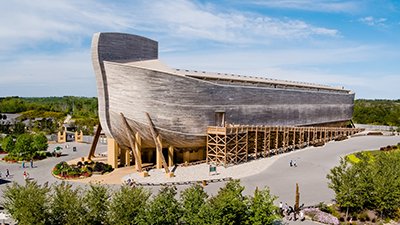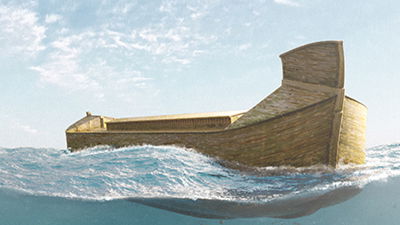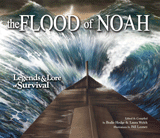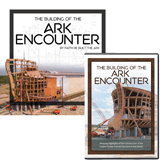
Feedback: Was Noah’s Ark Seaworthy, or Is That Impossible?
Part 3
Tim Lovett wraps up his response to a blogger regarding the seaworthiness of Noah’s Ark.
Plans for Ham's ark remain a tightly guarded secret
Seems like lots of public information published on the AiG website remains a secret to you. Pictures have been on the website for over two years.
but there is no doubt that it will be built upon a robust foundation. Northern Kentucky experiences freeze/ thaw cycles in the winter months and that heaving alone would soon negatively affect the integrity of the structure.
Noah probably built the Ark in a high place on a robust launching platform to minimize the chance of dashing against nearby obstacles. So, yes, Noah would have needed a robust foundation, and so will the (much lighter) AiG structure. But the Ark Encounter is not a ship-proving test either; it is an immersive experience with a structure based on reasoned design.
There are no Marine engineers on planet earth that have concluded that the ark could be seaworthy, that is, without some supernatural agent suspending the laws of physics and nature.
Now is a good time for someone to tell you that there are naval architects and marine engineers. Marine engineers work on ship machinery, whereas seaworthiness is the domain of naval architects.
For example, it was naval architects at the world-class ship research center KRISO (renamed MOERI in 2005) in Korea who studied Noah’s Ark in 1992 and declared the biblical specifications sound (see this summary for more information). The head of the study (Dr. S. W. Hong, an evolutionist) went on to run the place.
It is impossible for a ship of that material and construction
What construction? If you mean a rectangular box made from twenty-foot scantlings as you propose, then this is certainly doing it the hard way. Or perhaps you mean single-layer carvel construction with sails, like Pretoria and Orlando—or Wyoming or Great Republic even. Either way, this does not rule out other ways to build a seaworthy Ark. Nor does it preclude effective shear-resisting hull structures in wood. Here are a few examples:
- Diagonal planking (cold molded): This is the definitive way to build a strong wooden hull. This technique was used in minesweepers for the U.S. Navy (1990s). Modern adhesives and a fiberglass skin helped of course, but the British did the same in 1855 (Schomberg). Also, as already mentioned, diagonal planking appeared in World War I wooden steamers. In 1998, another old ship, the USS Constellation, was switched from carvel to diagonal planking to avoid using clumsy steel beams in order to repair hogging strains.1
- Mortise and tenon planking: Greeks and Romans used this spectacular (almost unbelievable) solution to shearing between planks. The method goes back well before the fourteenth century before Christ, but then it disappeared for centuries until rediscovered conclusively by modern underwater archaeology.2 This lends credence to the records of Ark-sized wooden ships of antiquity. For example, Athenaeus discussed a large warship that was 427 feet (130 m) long! It was built by Ptolemy Philopater around 250–200 BC.3 It proved quite capable in war, no less. Then there was the Leontifera—based on the specification of eight tiers of oarsmen, it is estimated at about 393 feet (120 m) long.4
- Multiple layers of planking: This method was clearly used in Chinese ships, which includes the treasure ships of Zheng He (1400s) with a reported length of 444 chi (137 m or 450 feet).5 Also seen in Greek and Roman ships (c. 80–90 BC).6 More recently (1800s) multiple layers were employed for impact with floating ice.7 Each successive layer of overlapping planking dramatically increases the shear resistance of the planking system. Even a double layer is “vastly superior to single carvel.”8
- Edge bolting: Vertical pins (drift bolts) connected horizontal members (strakes) together. This technique was used in late American ships to fasten ceiling strakes and keelsons together.9
Another problem for these “oversized” carvel ships was weak frames.10 To make the curved frame profiles, many short segments were bolted together, resulting in lateral flexibility (i.e., they could go out of shape). This could have been addressed by installing lateral shear walls at regular intervals (transverse bulkheads). The Chinese were doing that at least fourteen centuries earlier, which is twelve centuries before Benjamin Franklin “invented” it.11
So maybe Noah used ancient bulkheads and ancient planking.
to float on water for more than a very short period of time and anyone making the claim that Noah's ark as described in the bible was seaworthy is just plain nuts.
So out of the blackness of the Internet, you call the director general of research at MOERI, Dr. S. W. Hong and his team, “plain nuts”?
In summary, 300 feet (91 m) may well be the practical limit for single layer carvel hull construction, but more appropriate construction methods would extend that boundary by at least 50 percent.
With regards,
Tim
Footnotes
- Andrew Davis and Keith Gallion, A Cold Molded Shell for the USS Constellation, http://www.maritime.org/conf/conf-davis.htm.
- Lionel Casson, The Ancient Mariners, second edition (Princeton, NJ: Princeton University Press, 1991) p. 108. The practice of joining planks with mortise and tenon joints “certainly goes back to the 14th century BC and very much likely before that.”
- Athenaeus, The Deipnosophists, trans. Charles Burton Gulick, Loeb Classical Library 208 (Cambridge, MA: Harvard University Press, 1987), Book 5, Section 203f–204b, (2:421–425).
- Memnon, Excerpts, c. 14, 15, as cited by James Ussher, The Annals of the World, second printing, trans. Larry and Marion Pierce (Green Forest, AR: Master Books, 2003), p. 354.
- G. Deng, Maritime sector, institutions, and sea power of premodern China (Westport, CT: Greenwood Publishing Group, 1999). ”Chinese ships were maintained once a year by adding a layer of planks to the hull. As a rule, when six layers were added, the ships were half-retired from the ocean-going fleet to coastal services due to the ship’s loss of speed.” Claims of an Ark-like scale of Zheng He’s treasure ships have drawn skepticism (mostly by non-Chinese commentators), but it is agreed they were built with two or three layers of planks.
- Lionel Casson, Ships and Seamanship in the Ancient World (Baltimore, MD: The Johns Hopkins University Press, 1995). “The Mahdia wreck had double planking with bands of impregnated cloth between the layers.”
- Loney, Wrecks Along The Gippsland Coast.
- David H. Pascoe, “Surveying Wood Hulls, Part 3: Appendix,” http://marinesurvey.com/surveyguide/wood3.htm. “Double Planked: Same as carvel only uses light inner layer with heavier outer layer, parallel longitudinal. Vastly superior to single carvel. Much less prone to leaking, working and fastener failure.”
- Harvey Cole Estep, How Wooden Ships Are Built: A Practical Treatise on Modern American Wooden Ship Construction with a Supplement on Laying Off Wooden Vessels (Cleveland, OH: The Penton Publishing Co., 1918), p. 13. “In modern wooden vessels built on the coasts of the United States, considerable use is made of edge-bolting to fasten the various keel and keelson elements and the strakes of ceiling together. Edge bolting means fastening the pieces together longitudinally. In other words, the ceiling strakes are bolted through and through to each other, as well as being bolted to the frame timbers. There is no doubt that this form of fastening adds greatly to the strength of the hull structure, particularly in a longitudinal direction, offering resistance to hogging strains. In fact, some experts go as far as to say that the edge-bolting is all that prevents the largest of wooden ships from breaking-up in a seaway. This is probably an exaggeration, although it has been demonstrated that timbers well edge-bolted at least approximate the strength of single pieces of the size of the members so combined.”
- H. R. Milner and J. Peczkis, “Wooden Ship Hulls as Box Girders with Multiple Interlayer Slip,” Journal of Structural Engineering 133, no. 6 (June 2007): 855–861. “Frames consisting of many small timbers bolted together are readily deformed, and have frequently been identified as a major weakness of traditional wooden ships.”
- L. Xi, X. Yang, and X. Tang, eds., The History of Science and Technology in China: Transportation (Beijing, China: Science Press, 2004), p. 58. “It can now be deduced that the first watertight bulkheads appeared around 410.” The Chinese design was a deliberate shear wall, complete with dowel pins and ledges for shear resistance and even limber holes for maintenance. They form watertight compartments, of course, to keep the boat afloat if damaged.
Recommended Resources

Answers in Genesis is an apologetics ministry, dedicated to helping Christians defend their faith and proclaim the good news of Jesus Christ.
- Customer Service 800.778.3390
- © 2025 Answers in Genesis





